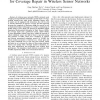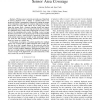380 search results - page 11 / 76 » A framework for multi-robot node coverage in sensor networks |
VTC
2010
IEEE
13 years 5 months ago
2010
IEEE
—In wireless sensor networks (WSN), stochastic node dropping and unpredictable node failure greatly impair coverage, creating sensing holes, while locally redundant sensors exist...
SENSYS
2003
ACM
14 years 22 days ago
2003
ACM
For many sensor network applications such as military surveillance, it is necessary to provide full sensing coverage to a security-sensitive area while at the same time minimizing...
WINET
2011
13 years 2 months ago
2011
Sleep scheduling, which is putting some sensor nodes into sleep mode without harming network functionality, is a common method to reduce energy consumption in dense wireless sensor...
AINA
2007
IEEE
14 years 1 months ago
2007
IEEE
— Wireless sensor networks are made up of hundreds of devices deployed over a distant or sensitive field to be monitored. Energy consumption is balanced by taking advantage of t...
MSN
2007
Springer
14 years 1 months ago
2007
Springer
Success of Wireless Sensor Networks largely depends whether the deployed network can provide desired coverage with acceptable network lifetime. This paper proposes a distributed pr...


